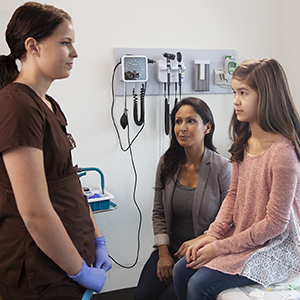Your Scoliosis Evaluation
If a school screening or your healthcare provider finds signs of scoliosis, you’ll visit an orthopedist for an evaluation. An orthopedist is a healthcare provider who treats bones and muscles. This visit helps figure out what treatment may be best for you.

During your evaluation
Your orthopedist may:
-
Ask you about your health history, such as if you’ve ever had surgery
-
Ask about your family health history, such as if someone in your family has scoliosis
-
Take X-rays of your back to get a closer look at your spine
-
Estimate how much more you are likely to grow. You may be asked if you've gotten your period yet.
-
Examine your back while you’re standing up and bending over
-
Measure the size, location, and pattern of the spinal curve
-
Test how flexible your spine is, and how strong your back and neck muscles are
Why treat scoliosis?
A serious spinal curve that isn’t treated can get worse as you grow. Over time, it may cause problems. These can include:
-
Back pain
-
Arthritis in your back
-
Your body looking twisted
-
Clothes not fitting right
-
Heart and breathing problems (rare)
Online Medical Reviewer:
Raymond Turley Jr PA-C
Online Medical Reviewer:
Stacey Wojcik MBA BSN RN
Online Medical Reviewer:
Thomas N Joseph MD
Date Last Reviewed:
4/1/2024
© 2000-2024 The StayWell Company, LLC. All rights reserved. This information is not intended as a substitute for professional medical care. Always follow your healthcare professional's instructions.